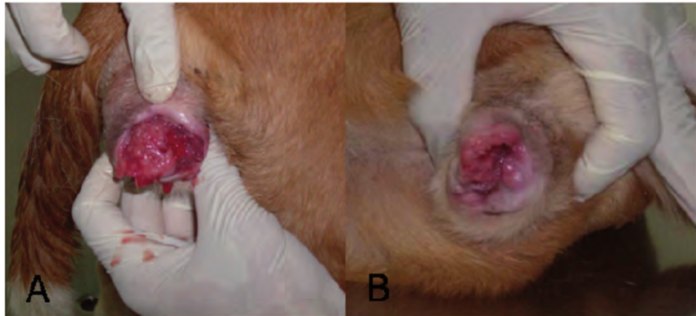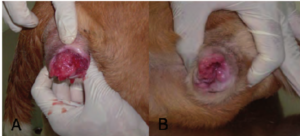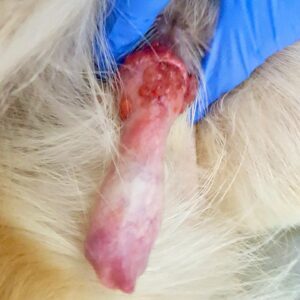Canine Transmissible Venereal Tumour (TVT): an Overview
Dr. Naiya parikh*, Dr. Bhautik saripadiya, Dr. Ajay damor
Department of Veterinary Gynaecology and Obstetrics, College of Veterinary Science and Animal Husbandry, Kamdhenu University, Anand
Corresponding author email – naiyaparikh8@gmail.com
INTRODUCTION
Transmissible Venereal Tumour (TVT) is a contagious neoplasm most common in sexually active dogs, recognized by various names such as sticker sarcoma, transmissible venereal granuloma, infectious granuloma, canine condyloma, and infectious lymphosarcoma. Typically transmitted during mating, this Tumour predominantly targets external genitalia, occasionally extending to internal genitalia. It exhibits a higher incidence in young, sexually active animals.
While generally classified as a benign reticuloendothelial Tumour, TVT distinguishes itself with its infrequent metastasis, particularly in immunocompromised animals. Remarkably, TVT cells display an abnormal chromosome count ranging from 57 to 64, with an average of 59 chromosomes, deviating from the typical 78 chromosomes in normal canine breeds. A transmissible venereal Tumour is the only proven example of a naturally occurring Tumour that is transmitted as an allograft by cell transplantation, and the Tumour becomes autonomous apart from the original host.
HISTORY
Canine Transmissible Venereal Tumour (CTVT) was first documented in the early nineteenth century, described in 1810 as an “ulcerous state” with a “fungus excrescence” in the reproductive organs by a London veterinary practitioner. In India, where uncontrolled mating among free-roaming canines is prevalent, CTVT stands out as the most common transmissible Tumour. This Tumour is widespread in semi-tropical and tropical regions, exhibiting a positive correlation with rainfall and annual temperature, while inversely related to geographic latitude. Prevalence studies highlight a higher occurrence in areas with free-roaming dogs, emphasizing the role of uncontrolled mating. Conversely, practices such as neutering and spaying contribute to a reduced prevalence of CTVT.
ETIOLOGY
Predisposing factors for Transmissible Venereal Tumour (TVT) include a rapid rise in stray dog populations, aging, and situations leading to immune suppression. Dogs with compromised immune systems are particularly susceptible to rapid Tumour growth and metastasis. TVT is predominantly found in dogs with weakened immune systems. The compromised immune system plays a pivotal role in both acquiring and spreading TVT.
TVT is transferred by:
- Sexual contact
- Direct contact with the infected Tumour, such as by licking, sniffing, scratching, or biting
- Mother to puppies through grooming
CLINICAL SIGNS
- The bleeding was observed as a very first clinical sign.
- In males, lesions were localized on glans penis, shaft of penis, base of penis and on preputial area.
- In females, sites of primary tumour were near vulva, vulvovaginal area, inside vagina, vaginal area and extra-vaginal area.
- Lesions from Transmissible Venereal Tumour (TVT) occasionally manifest in regions beyond the genital area. In cases of extra-genital localization, clinical diagnosis becomes more challenging. TVTs can present a variety of signs, including exophthalmos, skin bumps, and facial or oral deformation, along with regional lymph node enlargement. This diversity of symptoms complicates the clinical identification of TVT when it occurs outside the genital region.
- Macroscopically, can be solitary or multiple tumour masses with cauliflower-like growth, ulceration, hemorrhagic, friable, and irregular appearance can be seen. Lesions are fragile and mostly haemorrhagic as a result of low cohesion amongst neoplastic cells.
- Tumour size varies from millimeters (mm) to several centimeters (less than 1 to 3 mm in diameter) with a dark red to greyish pink colour. Lesions are small (1 to 3 mm in diameter), superficial and coloured pink to red at the onset of tumour formation. The masses can be 5-7 cm in diameter which then advances deeper into mucosa as multilobular subcutaneous lesions with diameter that can go beyond 10-15 cm. Tumour bleeds easily and while they become larger, usually ulcerate and gets contaminated.
| Fig. 1: |
| Fig. 2: |
- Canine transmissible venereal tumour (CTVT) exhibited a predictable growth pattern in naturally and experimentally induced cases, i.e., progressive phase, stable and regression phase.
DIAGNOSIS
- History
- Clinical Examination:
- Observation of characteristic lesions on or around the genital area.
- Assessment of other potential clinical signs, such as regional lymph node enlargement, exophthalmos, skin bumps, or facial and oral deformities in cases of extra-genital localization.
- Cytological Examination:
- Fine-needle aspiration or biopsy of the Tumour for cytological examination.
- Identification of characteristic round cells with a prominent nucleus, often in clusters.
- Histopathological Examination:
- Biopsy or excision of Tumour tissue for histopathological analysis.
- Examination of tissue sections under a microscope to confirm the presence of TVT and rule out other potential Tumours.
- Immunohistochemistry: Use of immunohistochemical techniques to further confirm the presence of TVT by detecting specific markers associated with the Tumour.
- PCR (Polymerase Chain Reaction):
- Molecular techniques like PCR can be employed to detect specific DNA sequences of TVT, providing a highly accurate diagnostic method.
- Radiographic and Imaging Studies: In cases of extra-genital involvement, imaging studies such as X-rays or ultrasounds may be conducted to assess the extent of the Tumour and its impact on surrounding structures.
Treatment
- Chemotherapy: Most preferred therapy for CTVT
- Radiotherapy
- Immunotherapy
- Surgical excision of tumour mass: Effective in only small and localized Tumour and there will be chances of recurrence in metastatic cases.
Prevention
- Spaying and Neutering:
- Sterilization of dogs helps control the population of stray dogs, reducing the likelihood of uncontrolled mating and transmission of CTVT.
- Responsible Breeding Practices:
- Encourage responsible breeding practices to avoid the unintentional transmission of CTVT during mating.
- Control of Stray Dog Population:
- Implementation of programs to control and manage stray dog populations in urban areas, where the risk of CTVT transmission is higher.
- Avoidance of Contact:
- Prevention of direct contact between infected and non-infected dogs, particularly during mating or through licking, biting, scratching, or sniffing.
- Regular Veterinary Check-ups:
- Routine veterinary examinations to detect and address potential cases of CTVT at an early stage.
- Public Awareness and Education:
- Educational campaigns to raise awareness among dog owners, breeders, and the general public about the risks, symptoms, and preventive measures related to CTVT.
- Quarantine Measures:
- Isolation and quarantine of infected dogs to prevent the spread of CTVT to healthy individuals.
- Health Monitoring in Endemic Areas:
- Increased health monitoring and surveillance in areas where CTVT is endemic, focusing on early detection and intervention.
- Promoting Immune Health:
- Strategies to enhance the overall immune health of dogs may reduce susceptibility to CTVT.





